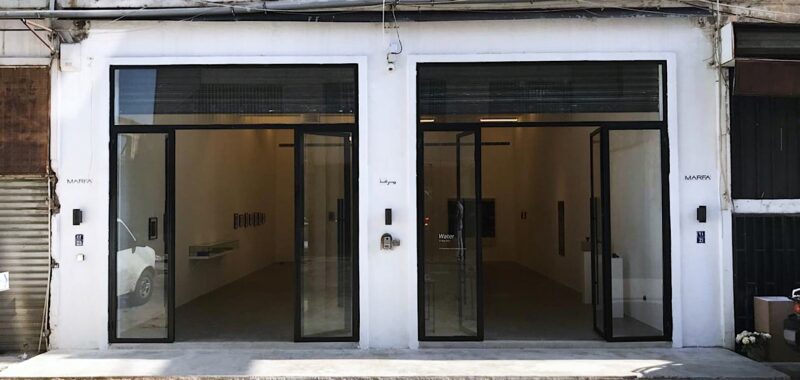Israeli strikes have killed nearly 700 people in Lebanon since Monday, according to the country’s health ministry. With a potential ground invasion looming on the horizon, the strikes on Beirut and in the southern and eastern portions of the country have forced residents to either evacuate or hunker down.
And across the region, cultural institutions and arts organizations are closing their doors to the public, uncertain what the next day — or hour — will bring.
“In a country already struggling with a harsh economic crisis, Israel’s war on Lebanon threatens our dreams for the arts and cultural sector to get back on its feet after the blast,” Karina El Helou, the director of Beirut’s Sursock Museum, told Hyperallergic. “Our heartfelt prayers go to the victims of this ongoing bloodbath in the region.”
The Sursock Museum temporarily closed to the public this week out of safety concerns. It has dismantled loaned works and the year-long Intimate Garden Scene (in Beirut) group exhibition early; curated by Christiane Tohmé, founder of the Lebanese arts group Ashkal Alwan, the show was slated to run until November 15.
The museum reopened to the public last May after undergoing extensive repairs that addressed damage from the port explosion that killed 218 people and displaced upwards of 300,000 residents in August 2020. Caused by hundreds of tons of haphazardly stored ammonium nitrate, the deadly blast decimated most of Beirut’s port district, which encompasses many of the capital city’s galleries, museums, and art centers.
For many Lebanese people, the strikes and pager attacks are part of what seems like a never-ending cycle of violence and instability since the end of the country’s 15-year civil war, which killed an estimated 150,000 Lebanese citizens and left hundreds of thousands more displaced. In the decades that followed, the country’s residents have witnessed revolving governments, escalations between Israeli and Hezbollah forces, mounting tensions between its various religious groups, and peaceful protests met with violent government suppression.

The political instability and social unrest is compounded by the country’s crippling economy over the last several years, in part due to a massive reduction in foreign tourism. Especially since October 7, travel advisories from countries like the United States, France, Italy, and the United Kingdom have increasingly deterred visitors amid Israel’s ongoing assaults on Gaza and the Occupied West Bank.
Visual artist Stéphanie Saadé, who was featured in the Sursock Museum show alongside over 60 artists, characterized the country’s adaptability to the near-constant violence as both “resilience and resignation.”
“You get used to hearing the sounds of explosions constantly. You’re not supposed to get used to these kinds of things, but you continue functioning despite everything,” Saadé told Hyperallergic over the phone from Paris, where she moved following the 2020 port explosion. It took her two years to return home because the incident was so traumatizing.
“The thing is that I realized, and many other Lebanese as well shared this with me, that we’re not healed yet from the blast. We’re not healed yet from our childhood,” Saadé said. “So it revives all these wounds that are not healed.”
“You can just end up as collateral damage, even if you’re not the target,” Saadé added.
Joumana Asseily, director of the Beirut gallery Marfa’ Projects, told Hyperallergic, “Hour by hour, day by day, we are managing.” Located in the port district, Marfa’ Projects was one of several galleries to suffer extensive damage from the 2020 explosion alongside Galerie Tanit, Sfeir Semler Gallery, and the Saleh Barakat Gallery.
Asseily said the gallery closed its doors on Saturday, September 21, and has been operating on a by-appointment basis as its small team prepares for upcoming art fairs in London and Paris.
“You have to keep working. You don’t know what tomorrow will be,” Asseily said. “Our work is very important, to continue to showcase the work of our artists is very important. To continue to do what we do is very important.”
In Saida, the country’s third-largest city located less than 30 miles south of Beirut, the Soap Museum has also closed its doors. A heritage institution housed in a 17th-century soap workshop and family residence, it has also been facing challenges with attendance amid the country’s declining tourism; over the past year and a half, not a single tourist has visited, the museum’s Director Christine Audi told Hyperallergic. Currently, the only staff on site are security personnel as the commute for many employees living in nearby villages is too precarious.
“There are two priorities: first of all, that the people are safe, and second that they keep their jobs,” Audi said.


“We keep having the same conversation decade after decade, and it’s not moving forward,” Beirut-born artist Reem Bassous, who also has Palestinian heritage, told Hyperallergic. Bassous currently lives with her family in Washington, DC, where she works as the artistic director for the Washington Studio School.
“I always tell my daughter that survival is the best form of resistance,” Bassous said, adding that she feels “luckier than a lot of people” in the sense that she can channel her feelings into her work.
Still, she has found the past year of Israeli attacks on Gaza difficult to directly contend with through her art because it is “too close” to the violence she grew up adapting to.
“People ask me, ‘Why aren’t you painting? What’s happening in Gaza?’” Bassous said. “We have had enough bodies displayed on social media … I don’t want to paint another dead Palestinian body. I don’t want to paint another demolished building. That’s not something at all that I’m interested in doing.”

